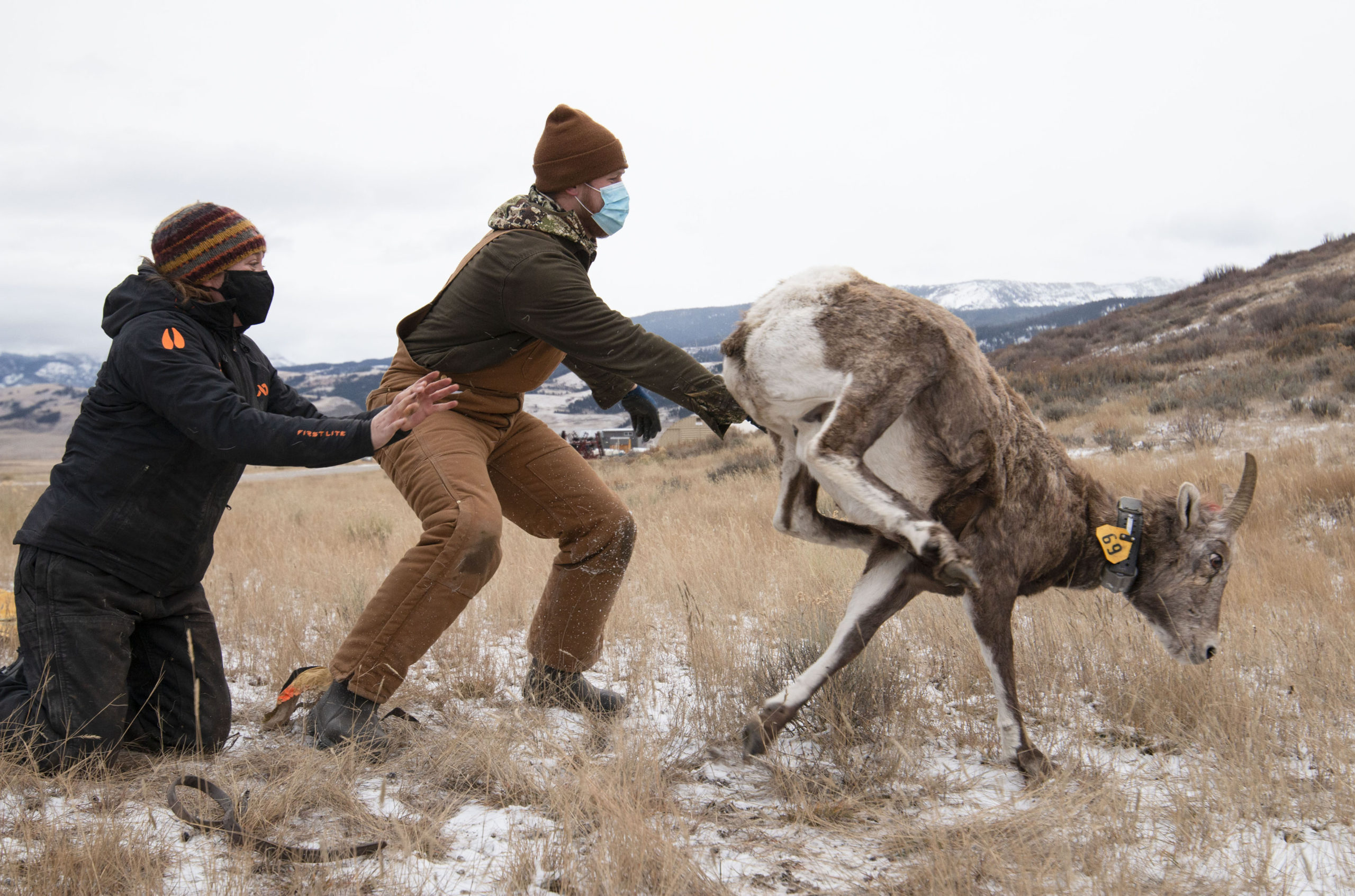
By Billy Arnold
Jackson Hole News&Guide
Via- Wyoming News Exchange
JACKSON — As a gaggle of grad students milled about, probing, prodding and drawing blood from three bighorn sheep, Aly Courtemanch was keeping her eyes peeled for something in particular.
Plump ewes.
“That one looks really good,” the Wyoming Game and Fish biologist said, pointing to one. But, making her way down the line just below the Bridger-Teton National Forest’s Curtis Canyon, she found a better contender.
“That one looks very, very good,” she said. “Really nice and healthy.”
But as the population of the Jackson Herd, which occupies the Gros Ventre range east of the valley, increases, not all of its wild, woolen members are looking so good.
Population fat levels, which biologists see as a measure of an animals’ nutrition, are declining, Courtemanch said.
And that has her and researchers like University of Wyoming professor Kevin Monteith worried that the sheep populations could be approaching another pneumonia driven die-off like one that killed 40% of the herd in 2012. So researchers are investigating whether limiting the number of sheep — and, consequently, limiting the amount the herd’s members can compete with one another for food — would prevent another pneumonia-driven die-off.
To do that they’re considering asking if the public would support a ewe hunt.
“The hypothesis is, if we can reduce numbers through hunting, we should see those sheep respond with better body conditions,” Courtemanch said. “That’ll be one of the first times, if not the first time, that’s ever been done.”
But it’s unclear what such a hunt would look like.
While cow elk are hunted every fall to manage herd numbers, bighorn sheep management is different.
The sheep exist in far fewer numbers than elk across the Mountain West and hunting tags are usually limited to rams — and generally scarce.
There were only 12 tags issued in 2021 for male bighorns in the Gros Ventre-dwelling Jackson Herd. And Courtemanch said a ewe hunt has been authorized only once before in Wyoming and rarely in other parts of the West. So it’s a relatively new tool.
Game and Fish plans to make a more detailed proposal, including how many tags might be offered, in March. An open house and chance for public comment would precede sending a proposal to the Wyoming Game and Fish Commission for approval in April.
That proposal would likely include plans to study how hunting impacts fat levels and body condition in the Jackson Herd, building on the research Courtemanch and University of Wyoming Professor Kevin Monteith were conducting last Thursday.
Pneumonia, introduced to Rocky Mountain bighorn sheep primarily through their interactions with domestic sheep, is often the culprit of massive population crashes in the wild herds. But different herds respond to pneumonia pathogens differently.
Monteith said the Whiskey Mountain herd, which lives around Dubois, has been “struggling mightily” for years. It experienced a major die-off in the ’90s and has continued to decline.
The Jackson Herd, by contrast, has gone through cycles of decline and rejuvenation.
That has scientists like Monteith and Courtemanch wondering why two sheep populations with the same diseases are performing differently. They’re looking to see which factors other than illness might play a role in the trajectory of the two populations.
“A lot of the focus before we started doing this was focused on chasing bugs,” Monteith said, pointing to mycoplasma ovipneumoniae, a bacterium that can cause pneumonia in bighorns.
But he said that just looking at the disease-causing microbes is only part of the picture.
“All these sheep have M. ovi,” Monteith said, using a shorthand name for the bacterium. “But their performance is so different.”
Recognizing that, he started to question what scientists were missing that could explain how different bighorn sheep populations are faring.
Being a nutritional ecologist, the Wyoming professor started to zero in on what an animal eats and their fat stores.
As a helicopter crew buzzed back and forth between the Curtis Canyon foothills, finding and capturing radio-collared sheep and then flying them back to a staging area, Courtemanch and Monteith were thinking about fat and how it relates to sheep health.
Generally, a chunky sheep is a healthy sheep. Measuring how girthy bighorns are can indicate how healthy the population is. Monteith — who has been called the “fat man” for his focus on lipids — said fat is not a proxy for an animal’s nutrition. It’s an all-encompassing measure of what animals go through, like birthing a lamb and finding quality food, or not.
“It’s a currency that tells us how good things were, how rough things were,” he said.
As the population of the Jackson Herd climbs, Courtemanch and Monteith are both thinking about body condition and how it relates to the bighorns’ ability to resist diseases like pneumonia. That’s because, in the past, as the herd has reached a population of about 500 sheep, its members have died in large numbers from pneumonia.
For example, herd counts plummeted 40% from 417 in 2011 to 243 in 2012. About 10 years earlier the same herd’s count fell from 503 to 132: a 73% decline over a few years.
As the population rebounds once again — the most recent count, in February, tallied 491 bighorns — Courtemanch said fat levels are declining.
That has her and Monteith considering whether the cycle of die-offs has something to do with body condition: Whether sheep populations grow to a level where they compete too much for food, end up less healthy and more susceptible to pneumonia, then catch the disease and die.
“Maybe we’re getting too many sheep,” Courtemanch said. “They’re having to compete for food, they’re not getting enough food, and so their fat is going down.”
So wildlife managers are eyeing a ewe hunt as a possible tool to prevent the sheep from outcompeting each other, depleting fat stores and body condition, and possibly setting the stage for a disease-driven die-off.
“As you get more and more animals on the landscape, there’s less food per animal,” Monteith said. “Then we see these crashes. So the thought is, well, what if we were able to moderate density in a part of this herd through a female harvest?”
They hypothesize that girthy sheep might have greater success surviving potentially fatal pathogens.
Last Thursday, as Courtemanch focused on gathering data from the captured bighorns, student researchers deployed a test that humans have become all too familiar with amid a global pandemic.
A student stuck a long swab up the nostril of a captured sheep. The student spun it a few times and then pulled out the white swab, now looking black and a little sludgy.
“Oh, that’s a little dirty,” Courtemanch said with a laugh. “That’s how we test for the pneumonia bacteria. Same as a COVID test.”







